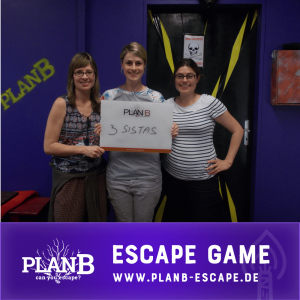Live Escape Games have taken the world by storm and appear in most cities. An exciting leisure activity that you can experience with friends, family and colleagues. What you may not have noticed is that most rooms are designed more for the individual gameplay than for the group.
Looking at the surveillance camera footage from the Escape Rooms, it seems that some players in a group tend to solve all the puzzles while others do little and just stand and watch.
You should never be too hasty with conclusions. Because the spectators have come especially for the visit in the Escape Room.
So it’s possible that the seemingly indifferent players really want to take part in the adventure in the Escape Room, but just don’t know what to do.
Before assuming that the groups that have booked a live escape game are a mix of a few enthusiastic players and several less interested in what’s happening in the escape game, you should take a look at how the puzzles are designed and make sure that the existing tasks and puzzles encourage teamwork.
This article will explain how this can be done.
LIVE ESCAPE GAMES – TREND ACTIVITY AND FUN ENTERTAINMENT OFFER
The numbers vary, but some larger cities already have hundreds of Escape Rooms on offer. Whether this is a consistent development or a trend for two, three or even five years remains to be seen. But what is already clear is that it is a trend in the leisure sector that most people have tried at least once before.
Of these players, a growing number are deciding to start their own Escape Room companies. Escape room owners come from a variety of professions: from former technology professionals to bar owners and accountants, more and more people are exploring and opening an Escape Room – the new interactive business.
A common feature among some owners, however, is that the Escape Room’s game design is not characterized by formal game design experience or training.
THE RESULT
What happens is that most game designs are used as a template for inserting puzzles that challenge the mind, logic, or spatial intelligence and are often frustrating to solve.
Typically, the game flow or sequence of events in which things happen is very linear. If that’s not the case, players have so many things to do that they don’t know where to start. Solve a puzzle to get some numbers (despite no credible relevance to the subject) and open a lock that will give you another clue to your next lock.
Such a linear sequence of the escape game testifies to the tendency to design escape rooms more for lone fighters than for a team. Because in a linearly structured escape game, players stand around when a particular puzzle doesn’t match their abilities or creativity, and the enthusiast in the group has all the fun.
THE PROBLEM
If a group is in a linear space and is stuck with a certain cipher, puzzle or logic puzzle, which is indispensable for the further course of the solution, then it is like an insurmountable wall – until someone with the right suitability (if you are lucky) is able to solve it. So everyone has to wait.
Puzzles that can be solved by individuals neglect those who want to participate in the Escape Room solution by solving individual part puzzles. This type of game design rewards the ambitious escape gamer, but not the rest of the group.
The lack of positive feedback can become a frustrating experience for some members of the group and create a dynamic of resignation. In later puzzles and tasks, the other players will not be so motivated to try to find the solution, as it is not very funny to be reminded again and again that they are not fast enough to solve them.
EXAMPLE: DESIGN FOR THE LONE FIGHTER
The riddle
Players must compare wine bottle labels with the countries they come from. To find out which is the missing country, they need to examine a journal entry with different prices and solve a mathematical question.
Required skills: A bunch of math and logic
In this scenario, player A doesn’t need player B’s support to solve the puzzle, and player B has nothing to do.
Player A: Great, I love math!
Person B: Oh. Oh, I’m bad at math. I’ll watch then.
Player A is excited about the puzzle. Player B waits or tries to solve something else, although he doesn’t know what.
Frustrated not to be able to contribute to the solution, player B relies on player A.
EXAMPLE: DEVELOPMENT FOR THE GROUP
The riddle
Players must compare the bottle labels with the countries they come from. The wine rack is behind a partially broken wall full of holes, and the only way to rotate the bottles and catch a glimpse of the label is by squatting and stretching.
To see the labels, the second person must stand normally and look through a smaller hole. Players must find the missing country by finding the reference from a newspaper article. However, the article is torn and some pages are missing, so someone has to search the room to find the missing pieces.
Skills. Teamwork, Physical Teamwork, physical dexterity, mathematics and logic.
This puzzle cannot be solved alone. Both player A and player B have to work together to get the clue.
Player A: Great, I love math!
Player B: Here are some magazine pieces I found, and if you give me a second, I can come up and spin the bottles for you.
Player A is excited about the puzzle. Player B has no interest in thinking too hard, but is still able to focus on the common goal through simple tasks. Player B realizes that there are certain parts of the game that he or she cannot help with, but there are many activities that he or she can solve.
Players A and B celebrate together.
WHY DID THIS WORK?
In an Escape Room adventure, the goal is to lead the player’s experience to an intended result. Just like a book, a puzzle or a new mobile game: if you end up frustrated or repeatedly failing, you are less inclined to read/play.
Well, in an Escape Room, players can’t just stop and leave the room even if they want to. So they are in conflict between the awareness that they have paid for the time to be there and the disillusionment of not knowing what to do or what to try.
In the Escape Game design for the group, the goal of space has never changed. But the design offered several ways for player B to get positive feedback:
Collecting scattered newspaper scraps is a rather low level of difficulty in the live escape game, but if it matches the narrative, is credible and allows movement, team satisfaction is the reward.
In order to reach the necessary height and be able to rotate the wine bottles, a physical effort is required – player B does not really need to think. Because there are several bottles to spin, both players are involved in the action.
The collaboration between the players in completing the escape game means that they can celebrate together, resulting in an improved team spirit. Positive feedback is the reward for working together.
WHY SHOULD YOU FOCUS ON THE GROUP FOR AN ESCAPE GAME DESIGN?
The reality of this kind of business is that everyone is different. For something else like a restaurant or a toy store, for example, consumers would simply choose the products that fit and go with them. In the live escape game, people don’t know in advance what to expect and they can’t leave if they want to.
If you ignore that and just design a series of puzzles based on puzzles and numbers – or puzzles that are irrelevant to the subject – the participants of the Escape Game will gather around those who might have an idea but are not sure and investigate every inch and every corner because everything else they tried doesn’t work and they have no more options.
Better not to focus on the puzzle, but on the tasks. Simple things like collecting related props, encouraging teamwork when objects need to be moved or examined, and passing information from one room to another, lead to easy victories and a sense of fulfillment for all involved in the Escape Room.
Of course, you don’t want to make it too easy. If players feel that a task in the Live Escape game has been deliberately pushed to give them something to do, the reverse effect will occur and players will not be willing to solve all the tasks you have designed for them. For example, if the newspaper from the previous example was divided into 20 pieces, it wouldn’t work so well.
CONCLUSION
To ensure that everyone who plays an escape game is both challenged and rewarded, there is no need to overhaul the entire design. Simple changes, like those in our example, can be enough. The circle of people who can successfully pass and solve the Escape Room will be significantly expanded and everyone can function as a team alongside their friends.
And a group that grows together will stay together and come back to play the Live Escape game again. Guaranteed.








